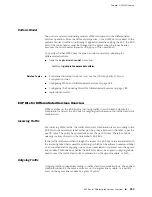
■
Flooding frequency—Periodicity with which the bandwidth value is flooded,
apart from any flooding due to value changes
■
Administrative weight—Weight assigned to the interface that supersedes any
assigned by the IGP
■
Attribute flags—32-bit value that assigns the interface to a resource class and
enables a tunnel to discriminate among interfaces by matching against tunnel
affinity bits
LSP Preemption
You can develop a preemption strategy whereby a new LSP can claim resources from
an existing LSP. Each tunnel can be configured with a
setup
priority and a
hold
priority.
Priority levels range from 0 (highest priority) through 7 (lowest priority).
If traffic engineering admission control determines that there are insufficient resources
to accept a request to set up a new LSP, the setup priority is evaluated against the
hold priority of existing LSPs. An LSP with a hold priority lower than the setup priority
of the new LSP can be preempted. The existing LSP is terminated to make room
(free resources) for the new LSP. You must assign priorities according to network
policies to prevent resource poaching and LSP thrashing.
Related Topics
■
See
Configuring MPLS
, for information about displaying information related to
traffic-engineering resources
Topology-Driven LSPs
Topology-driven LSPs are implemented for best-effort, hop-by-hop routing. In
topology-driven LSP mode, LDP automatically sets up LSPs for IGP, direct, and static
routes, subject to filtering by access-lists. JUNOSe supports downstream-unsolicited
LDP using the platform label space.
If you use the topology-driven LSP mode to forward plain IP packets, use the
ldp
ip-forwarding
command to place LSPs into the IP routing table for forwarding plain
IP traffic.
You can use the
mpls ldp advertise-labels
command to limit the number of routes
for which labels are advertised. In most cases, you can issue
mpls ldp
advertise-labels host-only
.
LDP over RSVP-TE
If you are running RSVP-TE in the core, LDP can tunnel through the core by stacking
an LDP LSP over an RSVP-TE LSP, as shown in Figure 58 on page 247. With LDP over
RSVP-TE, LDP establishes targeted sessions among the LDP routers at the edge of
the RSVP core. From the perspective of the LDP LSP, the RSVP-TE core is a single
hop.
246
■
Topology-Driven LSPs
JUNOSe 11.1.x BGP and MPLS Configuration Guide
Summary of Contents for BGP
Page 6: ...vi ...
Page 8: ...viii JUNOSe 11 1 x BGP and MPLS Configuration Guide ...
Page 37: ...Part 1 Border Gateway Protocol Configuring BGP Routing on page 3 Border Gateway Protocol 1 ...
Page 38: ...2 Border Gateway Protocol JUNOSe 11 1 x BGP and MPLS Configuration Guide ...
Page 234: ...198 Monitoring BGP JUNOSe 11 1 x BGP and MPLS Configuration Guide ...
Page 236: ...200 Multiprotocol Layer Switching JUNOSe 11 1 x BGP and MPLS Configuration Guide ...
Page 542: ...506 Monitoring BGP MPLS VPNs JUNOSe 11 1 x BGP and MPLS Configuration Guide ...
Page 544: ...508 Layer 2 Services Over MPLS JUNOSe 11 1 x BGP and MPLS Configuration Guide ...
Page 610: ...574 Virtual Private LAN Service JUNOSe 11 1 x BGP and MPLS Configuration Guide ...
Page 624: ...588 VPLS References JUNOSe 11 1 x BGP and MPLS Configuration Guide ...
Page 680: ...644 Virtual Private Wire Service JUNOSe 11 1 x BGP and MPLS Configuration Guide ...
Page 724: ...688 Monitoring MPLS Forwarding Table for VPWS JUNOSe 11 1 x BGP and MPLS Configuration Guide ...
Page 725: ...Part 6 Index Index on page 691 Index 689 ...
Page 726: ...690 Index JUNOSe 11 1 x BGP and MPLS Configuration Guide ...
















































